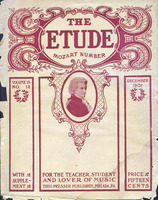The following statements are said to have been made, in a recent interview, by Camilla Urso:
“There is a regular course of study to be pursued for one who aims to become a fine violinist, as there is for one who desires to be graduated with highest honors. The usual time required to become an artist on the violin varies from six to nine years (according to the aptitude of the pupil) with constant study under a good teacher. After this has been accomplished, in order to retain what one has acquired, the same amount of practice is needed. Remember that what has been conquered by your fingers does not remain unless one practices daily. The mind can retain; but the fingers lose flexibility if not given daily practice. I practice five hours daily, and I never omit playing scales.”
It may, perhaps, be unnecessary to remark that, in all probability, Camilla Urso never made the foregoing statements ascribed to her. She is an excellent and thoughful (sic) artiste, and is not given to foolish utterances. But similar, and equally vague, statements are being constantly printed for the edification of young players, and often (as in the present instance) things are said which, for the good of the inexperienced, should either be flatly denied or made perfectly clear, as the case may be.
There is certainly a definite course to be pursued if one aims to become a fine violinist; but that this course occupies a period of from six to nine years, “with constant study under a good teacher,” is a decidedly misleading statement.
“Constant study under a good teacher!” Alas, how many striving, gifted pupils have the good fortune to spend the early years of their musical apprenticeship under the guidance of an honest, capable teacher? The fortunate ones are remarkably few and far between. Many months, if not several years, are generally wasted before the right teacher is found, and, not infrequently, it is then too late to perform the delicate work of musical reconstruction.
Concerning the advice wihch (sic) Camilla Urso is said to have given on the question of daily practice, comment is entirely superfluous, inasmuch as it is almost an impossibility for anyone with the vestige of a brain to imagine that artistic achievement is possible without constant and conscientious application. But what is, indeed, important for the pupil to understand, in this connection, is the necessity for rational daily study. Fitful study has never enduring value. Five hours one day, half an hour the next, two hours on the following day, etc., is a plan of study which can hardly be expected to have good results; yet the majority of students are easily tempted to work in this spasmodic fashion, and they foolishly imagine that it is useless to attempt to work when the spirit does not move them. If such students will make a reasonable effort to devote about four hours of every day to practice, they will quickly make the discovery that they have erred in their conception of inspiration and its effects. The pupil should acquire the habit of practicing a reasonable number of hours every day. While it is true that occasionally one’s physical or mental condition is such as to render the effort to study a useless and unprofitable exertion, such a condition is the exception, not the rule.
As to the statement that Camilla Urso practices five hours daily—Well, that is hardly a fish-story, but it is strangely fishy.



